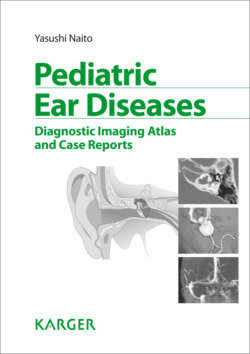Читать книгу Pediatric Ear Diseases - Y. Naito - Страница 7
На сайте Литреса книга снята с продажи.
ОглавлениеNote Concerning Images Used in This Book
Most of the images shown in this book are temporal bone CTs, but in some cases MRIs are also employed to observe structures such as the inner ear, internal auditory canal, and posterior cranial fossa. The temporal bone imaging parameters described below pertain to the majority of the images contained herein. Although different parameters are employed in a portion of the CT and MR images, a detailed explanation of each would be of little clinical significance. As most readers who are not radiologists are likely unfamiliar with the values described below, we recommend that, when asked for direction regarding temporal bone CT or MRI examination procedures by radiologists either at your own facility or at an outsourced imaging lab, you photocopy this page and present it as an example. However, regarding the voxel size values shown below, please be aware that these are the sizes of the minimum units comprising the image and structures smaller than this cannot be isolated and depicted, so represent the maximum resolution of the images shown herein.
As a general rule, the images shown are rectangular with an aspect ratio of 3:4. The axial cross-sections display the area indicated inside the box in figures 1 (CT) and 2 (MRI) below, centered on the inner ear and tympanic cavity. The coronal cross-sections generally display the area from the inferior margin of the mastoid process to the superior margin of the anterior semicircular canal.
Temporal Bone Target CT Imaging Parameters
Fig. 1. Temporal bone CT image
Principal equipment used: GE BrightSpeed (16 MD CT), 120 kV, helical pitch of 0.562, “Bone” reconstruction algorithm. Axial cross-sections: bilateral simultaneous imaging, FOV: 150 mm, matrix size: 512 × 512, slice thickness: 0.625 mm, no gap (voxel size: 0.29 × 0.29 × 0.63 mm). Coronal cross-sections: unilateral imaging, FOV: 96 mm, matrix size: 512 × 512, slice thickness: 0.625 mm, no gap. Display window width is 3800, window level is 30.
A number of problems arise when attempting to display in print form clinical images normally viewed either as backlit transparencies or on a computer display. It is difficult in actual printed images to fully satisfy the conflicting objectives of losing as little information included in the image as possible while preventing the display of data that should not have been shown in the original image. We have made an effort to fulfill both objectives as much as possible but, in some images, areas that were originally air are sometimes depicted as slightly shaded, or structures such as tympanic membranes or tendons that should be delicately expressed with intermediate gradations become difficult to distinguish. We hope that you will take the above difficulties into consideration when viewing the images presented in this book.
Temporal Bone MR Imaging Parameters
Fig. 2. Temporal bone MRI
Equipment used: Siemens Avanto 1.5T MRI system, SPACE (Sampling Perfection with Application optimized Contrasts using different flip angle Evolution) pulse sequence, Turbo Spin Echo, 3D T2-weighted images. Imaging parameters: FOV: 170 mm, slice thickness: 0.7 mm, matrix size: 256 × 256 (voxel size: 0.66 × 0.66 × 0.7 mm), TR: 1300 ms, TE: 253 ms, flip angle: 160 deg (variable), number of excitations: 2. GRAPPA used for parallel imaging.
